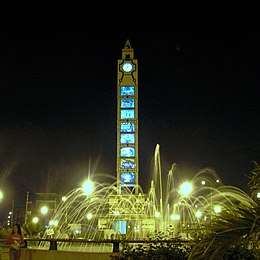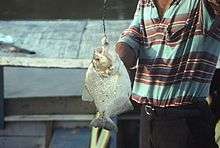Department of Ucayali
Ucayali (Spanish pronunciation: [ukaˈʝali]) is an inland department of Peru. Located in the Amazon rainforest, its name is derived from the Ucayali River. Its capital is the city of Pucallpa.


Department of Ucayali | |
|---|---|
Department | |
.svg.png) Flag .svg.png) Seal | |
.svg.png) Location of the Ucayali department in Peru | |
| Coordinates: 9.96°S 73.19°W | |
| Country | Peru |
| Subdivisions | 4 provinces and 14 districts |
| Largest city | Pucallpa |
| Capital | Pucallpa |
| Government | |
| • Governor | Francisco Pezo Torres (2019–2022) |
| Area | |
| • Total | 101,830.64 km2 (39,317.03 sq mi) |
| Elevation (Capital) | 120 m (390 ft) |
| Highest elevation | 350 m (1,150 ft) |
| Lowest elevation | 135 m (443 ft) |
| Population (2017) | |
| • Total | 496,459 |
| • Density | 4.9/km2 (13/sq mi) |
| UBIGEO | 25 |
| Dialing code | 061 |
| ISO 3166 code | PE-UCA |
| Principal resources | Wood, fruit. |
| Poverty rate | 70.5% |
| Percentage of Peru's GDP | 0.85% |
| Website | www.regionucayali.gob.pe |
Geography
Demographics
Population
According to the 2007 Census, the Ucayali department has a population of 432,159 inhabitants, 51.4% of which (222,132) are male and 48.6% (210,027) are female. 75.3% of the population (325,347) live in urban areas while the remaining 24.7% (106,812) live in rural areas.
As of 2002, the Instituto Nacional de Estadística e Informática estimated the department's population to be 468,922.
Languages
Spanish is spoken as a first language by 87.6% of the population, while 4.1% speak Asháninka, 1.5% speak Quechua and 0.1% speak Aymara. Other indigenous languages, including Shipibo, are spoken by 6.6% of the population and 0.0% speak foreign languages.
Immigration
Persons originating from other departments of the country make up 34.7% of the population and 0.2% of residents were born abroad.
The largest immigrant groups come from the Loreto Region (12.5% of the total population).
Age
The population is spread out with 53.9% under the age of 20, 9.3% from 20 to 24, 25.4% from 25 to 44, 8.8% from 45 to 64, and 2.5% who are 65 years of age or older.
Education
Secondary education has been attended by 29% of the population and 2.3% also have graduated from non-university higher education, while 1.7% have complete university studies. 49.3% only have attended primary education and 9.1% have not had any education.
The illiteracy rate in the region is 14.2%
Political division
The department is divided into 4 provinces (Spanish: provincias, singular: provincia), which are composed of 14 districts (distritos, singular: distrito).
Provinces
The provinces, with their capitals in parentheses, are:
- Atalaya (Atalaya)
- Coronel Portillo (Pucallpa)
- Padre Abad (Aguaytía)
- Purús (Esperanza)